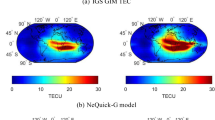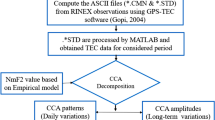Abstract
The ionospheric mapping function (MF) converts the line-of-sight slant total electron content (STEC) into the vertical total electron content (VTEC) and vice versa, and it is an important function in the creation and use of ionospheric models. Most of the existing MFs are only related to satellite elevation angle, the accuracy is low, and it is necessary to establish a MF with higher accuracy. Therefore, this paper considers the differences of MF for different local time (LT) and DOY (day of year), and uses the Global Navigation Satellite Systems (GNSS) STEC observation data from International GNSS Service (IGS) tracking stations in the northern hemisphere mid-latitude region in 2016–2020 to establish a novel MF model. First, we retrieve the mapping coefficient \(\alpha_{h}\) for different LT and DOY, where the results show significant correlation with LT and DOY, and other periodic variations. Then, we use the empirical orthogonal functions (EOF) to decompose the time series, and the first four order EOF components can describe 98.31% of the total variability. Finally, the periodic function is used to fit the time series of EOF, and a small number of model coefficients are obtained. This work employs the differential STEC of 28 IGS tracking stations in the mid-latitudes of the northern hemisphere in 2020 to verify the accuracy of the new MF and compare it with the widely used modified single-layer model (MSLM) MF. The results show that the accuracy of the new MF is higher than the existing MSLM MF when using JPLG (Jet Propulsion Laboratory’s final Global Ionospheric Maps) to convert VTEC to STEC. Compared with MSLM MF, the RMS of the new MF is reduced by 0.24 TECU on average, and the maximum reduction is close to 0.4 TECU (~ 25%). Among the 28 tracking stations that participated in the verification, the new MF is better than MSLM MF on most days, with 7 stations reaching 100% and 20 stations exceeding 95%. For nearly 60% of the days in 2020, the accuracy of the new MF for all tracking stations is better than that of MSLM MF.








Similar content being viewed by others
Data availability
The multi-GNSS observables data used in the paper are freely accessible via the CDDIS website https://cddis.nasa.gov/archive/gnss/data/campaign/mgex/, and the final GIMs “JPLG” provided by JPL are also available at the CDDIS website https://cddis.nasa.gov/archive/gnss/products/ionex/. The XUST’s DCBs data that support the findings of this study are available from the corresponding author upon reasonable request.
References
Ansari K, Park KD, Panda SK (2019) Empirical Orthogonal Function analysis and modeling of ionospheric TEC over South Korean region. Acta Astronaut 161:313–324
Birch MJ, Hargreaves JK, Bailey GJ (2002) On the use of an effective ionospheric height in electron content measurement by GPS reception. Radio Sci 37(1):1–19
Calabia A, Jin S (2020) New modes and mechanisms of long-term ionospheric TEC variations from global ionosphere maps. J Geophys Res Space Phys 125(6):e2019JA027703
Chen P, Yao Y, Yao W (2017) Global ionosphere maps based on GNSS, satellite altimetry, radio occultation and DORIS. GPS Solut 21(2):639–650
Chen P, Liu H, Ma Y (2020) Empirical orthogonal function analysis and modeling of global ionospheric spherical harmonic coefficients. GPS Solut 24(3):1–17
Chen P, Liu L, Liu H, Yao W (2021) Accuracy evaluation of XUST’s global ionospheric products. Adv Space Res 68(1):201–213
Chen P, Liu H, Schmidt M, Yao Y, Yao W (2022) Near real-time global ionospheric modeling based on an adaptive Kalman filter state error covariance matrix determination method. IEEE Trans Geosci Remote Sens. https://doi.org/10.1109/TGRS.2021.3091705
Clynch JR, Coco DS, Coker C, Bishop GJ (1989) A versatile GPS ionospheric monitor-high latitude measurements of TEC and scintillation. In: 2nd International technical meeting institute of navigation satellite division, vol 2, pp 445–450
Foelsche U, Kirchengast G (2002) A simple “geometric” mapping function for the hydrostatic delay at radio frequencies and assessment of its performance. Geophys Res Lett 29(10):111–121
Hernández-Pajares M, Juan JM, Sanz J, Orus R, Garcia-Rigo A, Feltens J et al (2009) The IGS VTEC maps: a reliable source of ionospheric information since 1998. J Geodesy 83(3–4):263–275
Hernández-Pajares M, Juan JM, Sanz J, Colombo OL (2002) Improving the real-time ionospheric determination from GPS sites at very long distances over the equator. J Geophys Res Space Physics 107(A10):1296
Hernández-Pajares M, Juan JM, Sanz J, García-Fernández M (2005) Towards a more realistic ionospheric mapping function. XXVIII URSI General Assembly, Delhi
Hernández-Pajares M, Roma-Dollase D, Krankowski A, García-Rigo A, Orús-Pérez R (2017) Methodology and consistency of slant and vertical assessments for ionospheric electron content models. J Geodesy 91(12):1405–1414
Horvath I, Essex EA (2000) Using observations from the GPS and TOPEX satellites to investigate night-time TEC enhancements at mid-latitudes in the southern hemisphere during a low sunspot number period. J Atmos Solar Terr Phys 62(5):371–391
Hugentobler U, Schaer S, Beutler G, Bock H, Dach R, Jäggi A, et al (2000) CODE IGS analysis center technical report 2002
Jiang H, Wang Z, An J, Liu J, Wang N, Li H (2018) Influence of spatial gradients on ionospheric mapping using thin layer models. GPS Solut 22(1):1–14
Karanam S, Ratnam DV, Dabbakuti JK (2019) Ionospheric time delay corrections based on the extended single layer model over low latitude region. Geodesy Geodyn 10(3):235–240
Klobuchar JA (1975) A first-order, worldwide, ionospheric, time-delay algorithm, vol 75, no 502. Air Force Cambridge Research Laboratories, Air Force Systems Command, United States Air Force
Klobuchar JA (1987) Ionospheric time-delay algorithm for single-frequency GPS users. IEEE Trans Aerosp Electron Syst 3:325–331
Komjathy A, Sparks L, Mannucci AJ, Coster A (2005) The ionospheric impact of the october 2003 storm event on wide area augmentation System. GPS Solut 9(1):41–50
Kong J, Yao Y, Liu L, Zhai C, Wang Z (2016) A new computerized ionosphere tomography model using the mapping function and an application to the study of seismic-ionosphere disturbance. J Geodesy 90(8):741–755
Lear WM (1987) GPS navigation for low-earth orbiting vehicles, 1st rev., NASA Rept
Lejeune R, El-Arini MB, Doherty P, Klobuchar J, De Paula E, Rodrigues F, Canavitsas A (2003) Performance of SBAS ionospheric estimation in the equatorial region. In: Proceedings ION GPS/GNSS 2003. Institute of Navigation, Portland, Oregon, September 9–12, pp 1658–1669
Li M, Yuan Y, Zhang B, Wang N, Li Z, Liu X, Zhang X (2018) Determination of the optimized single-layer ionospheric height for electron content measurements over China. J Geodesy 92(2):169–183
Li S, Zhou H, Xu J, Wang Z, Li L, Zheng Y (2019) Modeling and analysis of ionosphere TEC over China and adjacent areas based on EOF method. Adv Space Res 64(2):400–414
Li C, Peng H, Huang LK, Liu LL, Xie SF (2020) Research on short-term ionospheric prediction combining with EOF and ARIMA model over Guangxi area. Int Arch Photogram Remote Sens Spat Inf Sci 42:1147–1153
Lyu H, Hernandez-Pajares M, Nohutcu M, Garcia-Rigo A, Zhang H, Liu J (2018) The Barcelona ionospheric mapping function (BIMF) and its application to northern mid-latitudes. GPS Solut 22(3):1–13
Nava B, Radicella SM, Leitinger R, Coïsson P (2007) Use of total electron content data to analyze ionosphere electron density gradients. Adv Space Res 39(8):1292–1297
Pearson K (1901) LIII. On lines and planes of closest fit to systems of points in space. Lond Edinburgh Dublin Philos Magn J Sci 2(11):559–572
Schaer S (1999) Mapping and predicting the earth’s ionosphere using the global positioning system. Ph.D. thesis, Univ. Bern, Bern, Switzerland
Smith DA, Araujo-Pradere EA, Minter C, Fuller-Rowell T (2008) A comprehensive evaluation of the errors inherent in the use of a two-dimensional shell for modeling the ionosphere. Radio Sci 43(6):1–23
Su K, Jin S, Jiang J, Hoque M, Yuan L (2021) Ionospheric VTEC and satellite DCB estimated from single-frequency BDS observations with multi-layer mapping function. GPS Solut 25(2):1–17
Wang XL, Wan QT, Ma GY, Li JH, Fan JT (2016) The influence of ionospheric thin shell height on TEC retrieval from GPS observation. Res Astron Astrophys 16(7):116
Xiang Y, Gao Y (2019) An enhanced mapping function with ionospheric varying height. Remote Sens 11(12):1497
Ya’acob N, Abdullah M, Ismail M (2008) Determination of GPS total electron content using single layer model (SLM) ionospheric mapping function. Int J Comput Sci Netw Secur 8(9):154–160
Yuan L, Jin S, Hoque M (2020) Estimation of LEO-GPS receiver differential code bias based on inequality constrained least square and multi-layer mapping function. GPS Solut 24(2):1–12
Yue X, Schreiner WS, Hunt DC, Rocken C, Kuo YH (2011) Quantitative evaluation of the low Earth orbit satellite based slant total electron content determination. Space Weather 9(9):S09001
Zhang M, Liu L, Li Q (2021) Modeling the global ionospheric electron densities based on the EOF decomposition of the ionospheric radio occultation observation. Adv Space Res 68(5):2218–2232
Zhao J, Zhou C (2018) On the optimal height of ionospheric shell for single-site TEC estimation. GPS Solut 22(2):1–11
Zhong J, Lei J, Dou X, Yue X (2016) Assessment of vertical TEC mapping functions for space-based GNSS observations. GPS Solut 20(3):353–362
Zus F, Deng Z, Heise S, Wickert J (2017) Ionospheric mapping functions based on electron density fields. GPS Solut 21(3):873–885
Acknowledgements
The authors thank the IGS MGEX for providing the multi-GNSS data, the Jet Propulsion Laboratory (JPL) for providing the final GIMs “JPLG,” and XUST (Xi’an University of Science and Technology) for providing the satellite and receiver DCBs products. This work was supported in part by the National Natural Science Foundation of China under Grant 41404031, in part by the Outstanding Youth Science Fund of Xi’an University of Science and Technology under Grant 2018YQ2-10, and in part by Beijing Key Laboratory of Urban Spatial Information Engineering under Grant 20210206. Thanks to the reviewers for their valuable comments.
Author information
Authors and Affiliations
Contributions
PC, RW and YBY provided the initial idea and designed the research; PC and RW processed data and wrote the manuscript; ZYA helped to accomplish some test; ZYA and ZHW helped with the writing. All authors provided critical feedback and helped to shape the analysis and manuscript.
Corresponding author
Appendix
Appendix
See Tables 4, 5, 6, 7, 8, 9, and 10.
Rights and permissions
About this article
Cite this article
Chen, P., Wang, R., Yao, Y. et al. A novel ionospheric mapping function modeling at regional scale using empirical orthogonal functions and GNSS data. J Geod 96, 34 (2022). https://doi.org/10.1007/s00190-022-01624-x
Received:
Accepted:
Published:
DOI: https://doi.org/10.1007/s00190-022-01624-x




